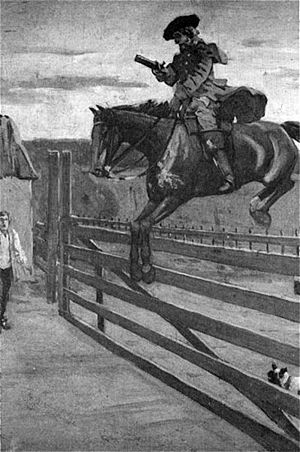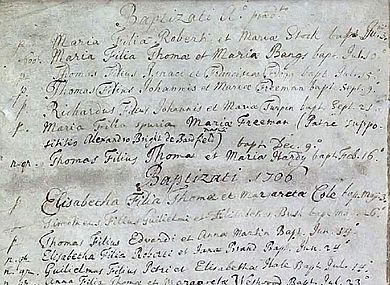Dick Turpin facts for kids
Quick facts for kids
Dick Turpin
|
|
|---|---|

Turpin imagined in William Harrison Ainsworth's novel Rookwood
|
|
| Born |
Richard Turpin
21 September 1705 (baptised) Hempstead, Essex, England
|
| Died | 7 April 1739 (aged 33) Knavesmire, York, England
|
| Cause of death | Execution by hanging |
| Other names | John Palmer |
| Occupation |
|
| Spouse(s) | Elizabeth Millington |
| Children | 1 (uncertain) |
| Conviction(s) | Guilty |
| Criminal charge | Horse theft |
| Penalty | Death |
Richard Turpin (born 21 September 1705 – died 7 April 1739) was a famous English highwayman. A highwayman was a robber who stopped people on roads, often on horseback. Turpin became well-known after he was executed in York for horse theft.
Turpin might have worked as a butcher, like his father, when he was young. But by the early 1730s, he joined a group of deer thieves. Later, he became a poacher, a burglar, and a horse thief. He is also famous for a made-up story about riding 200 miles overnight from London to York on his horse, Black Bess. This story was made popular by the writer William Harrison Ainsworth almost 100 years after Turpin died.
Richard (Dick) Turpin was born at the Blue Bell Inn in Hempstead, Essex. He was the fifth of six children born to John Turpin and Mary Elizabeth Parmenter. He was baptised on 21 September 1705.
Contents
Biography
Turpin's father was a butcher and also ran an inn. Some stories say that Dick Turpin followed his father's jobs. One story suggests he was a butcher's apprentice (a trainee) in Whitechapel when he was a teenager. Another story says he had his own butcher's shop in Thaxted.
Records from his trial in 1739 show that he had some basic schooling. He married Elizabeth Millington around 1725, but the exact date is not known. After his training, they moved to Buckhurst Hill, Essex, where Turpin opened a butcher's shop.
Joining a Gang
Turpin probably started working with the Essex gang of deer thieves in the early 1730s. This gang was also called the Gregory Gang. They needed people to help them sell the deer they stole. Turpin, being a young butcher in the area, likely became involved.
By 1733, Turpin may have left his butchery job because the gang's luck was changing. He then became the owner of a pub, probably the Rose and Crown at Clay Hill. There is no proof that Turpin was directly involved in the thefts at first. However, by the summer of 1734, he was closely connected to the gang. This suggests he might have known them for some time.
Becoming a Highwayman
Turpin became a highwayman after other members of his gang were arrested in 1735. He then disappeared for a while. He reappeared in 1737 with two new partners. One of these partners died, and Turpin ran away. Soon after, he also escaped from a man who tried to catch him.
Later that year, Turpin moved to Yorkshire. There, he used a fake name, John Palmer. He was staying at an inn when local judges became suspicious of "Palmer." They started asking how he paid for his lifestyle. "Palmer" was thought to be a horse thief and was put in York Castle. He was to be tried at the next court session.
Arrest and Execution
Turpin's real identity was found out when a letter he wrote to his brother-in-law from prison was discovered by the authorities. On 22 March 1739, Turpin was found guilty of two charges of horse theft. He was sentenced to death. He was hanged at Knavesmire on 7 April 1739.
After his death, Turpin became a legend. He was often shown as a brave and exciting hero in English songs and plays in the 1700s and 1800s. He also appeared in films and on television in the 1900s.
Legacy
Stories about Turpin continued to be published even into the 1900s. His legend also appeared on stage and in movies.
In 1845, a writer named George Dibdin Pitt created a play about Turpin's life. In 1846, Marie Tussaud added a wax figure of Turpin to her famous collection at Madame Tussauds. A theatre called Astley's Amphitheatre even put on a horse show called Dick Turpin's Ride to York.
In 1906, actor Fred Ginnett wrote and starred in a film called Dick Turpin's Last Ride to York. Dick Turpin's Ride to York was a British silent film from 1922. It was the first full-length movie about the story. For many years, film experts thought it was completely lost, but two parts were found again in 2003. Other silent movies about Turpin were also made. Some even showed Turpin as a hero like Robin Hood.
Sid James played Turpin in the 1974 Carry On movie Carry On Dick. LWT cast Richard O'Sullivan as Turpin in their TV series Dick Turpin (1979–1982). Noel Fielding will star as Turpin in a new TV series for Apple TV+.
There is a street in Feltham, near London's Heathrow Airport, named Dick Turpin Way. This is because people believed Turpin used to hide in the nearby Hounslow Heath.
Images for kids
-
Epping Forest was a place the Essex Gang often visited.
-
William Powell Frith's 1860 painting of Claude Duval, another highwayman, shows a romantic view of highway robbery.
-
Thomas Pelham-Holles, 1st Duke of Newcastle, pushed for Turpin to be tried in London.
-
A poster for Dick Turpin, a 1925 American silent film starring the cowboy actor Tom Mix.
See also
 In Spanish: Dick Turpin para niños
In Spanish: Dick Turpin para niños







